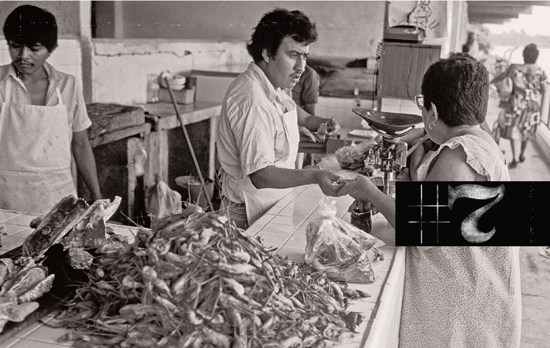
A shrimp stall at an open-air seafood market on the Mexican Gulf Coast
Chapter 7

The shrimp fajitas at the Palmetto Inn on South Padre Island come in a sizzling comal with onions and peppers. They are made with fresh Texas brown shrimp. The chain originated in Brownsville, home of the state’s largest shrimp fleet. • “We started serving seafood in 1962 at the Palmetto Inn’s Shrimp Boat restaurant in Brownsville,” Christy Carrasco, the restaurant’s owner, told me. Though I had eaten at the Palmetto Inn on beach vacations on South Padre Island before, I was clueless about the chain’s long history until I met Christy and started asking questions.
She invited me to meet her at the restaurant one afternoon. I found her waiting with a big brown envelope full of old photos. The first Palmetto Inn was opened in Brownsville in 1945 by Christy’s father-in-law, Moises M. Carrasco, she said. She showed me photos of the Palmetto’s founding father. He looked like he knew how to enjoy himself. There were photos of Moises and the family on a sailboat in Acapulco and several photos of trophy sailfish they had landed on deep-sea fishing expeditions.
Moises had six children and as the family grew, his heirs built restaurants in high-traffic locations in Harlingen, McAllen, Corpus Christi, Weslaco, and San Antonio. The northernmost location of Palmetto Inn was on “The Circle” in Waco across from the legendary Elite Circle Grill.
Not only did Moises Carrasco serve fresh shrimp at his restaurants, he also signed a license with Colonel Sanders for Palmetto Inns to become the first outlets for the Colonel’s famous fried chicken—long before the Kentucky Fried Chicken chain had its own locations.
She showed me pictures of what the Palmetto Inns had once looked like. I loved the old cars and the neon signs. I particularly liked a photo of Nancy Reagan eating dinner with Roger Staubach with a gaudy velvet painting on the wall behind them.
The Palmetto Inn chain not only introduced Tex-Mex seafood and the Colonel’s fried chicken to South Texans, it became one of the most successful restaurant chains in the state. The end came suddenly when the interstate highway system debuted in the early 1960s. The limited-access freeways diverted traffic from the cross-country routes and doomed the old-fashioned roadhouse restaurants that once thrived all across Texas.
“When I-35 was completed, Moises started closing the restaurants,” Christy said. “It was just like what happened to those wonderful diners along Route 66.”
The Palmetto Inn location in McAllen was recently sold to one of its employees, who renamed it Garcia’s. The South Padre Island location is the last remnant of the once proud chain and serves as a reminder of where Tex-Mex seafood dishes like shrimp fajitas got started.
“This is all that’s left,” Christy said, pointing to the walls of the old hurricane-battered building around her. “It’s the end of an era.”
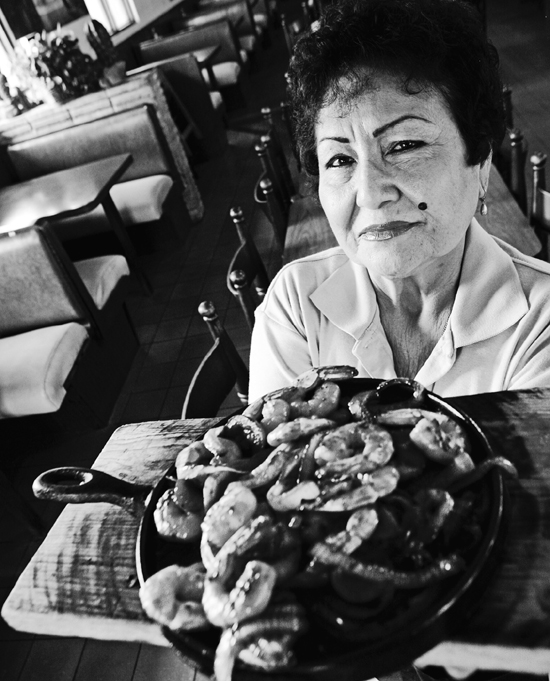
A sizzling comal of shrimp fajitas at the Palmetto Inn on South Padre Island
Wild Texas Brown Shrimp
Texas remains one of America’s top shrimp-producing states, but the fishery is in decline. Wild Gulf Coast brown shrimp are being replaced in the marketplace by imported farm-raised white shrimp. Outside of Texas, consumers like the milder flavor of white shrimp better.
Gulf brown shrimp have a distinctive aroma and taste that most consumers describe as an “iodine flavor.” The chemical is actually bromine, not iodine, according to Russell Miget, associate professor of seafood technology for Texas A&M University. The “iodine flavor” has no relationship to the dark vein on the back of the shrimp. That vein, which is actually the digestive tract, does not affect flavor. There is no reason for its removal other than aesthetics (or squeamishness).
About half of the shrimp sold in Texas is brown shrimp and it’s one of the only places where it’s still eaten, according to Jim Gossen of Louisiana Foods, one of the largest shrimp dealers in Houston. That bromine or iodine flavor comes from the kelp that brown shrimp in the Gulf of Mexico feed on.
White shrimp is the only kind of shrimp that’s farm-raised and it’s become the dominant shrimp sold in the United States, Gossen said. Whether they are white or brown, wild shrimp have a richer flavor and firmer texture than farm-raised shrimp because they feed on crustaceans and seaweed and swim freely.
Limited amounts of pink shrimp and various imported species like Thai tiger shrimp are available in Texas, too. Tiger shrimp are mild-tasting shrimp that are predominantly farm-raised in Asia. These shrimp are not as dense as the white or brown gulf shrimp. They are lower in cost, have a higher moisture content, and shrink more when cooked.
“When you are cooking spicy food, you need to have a stronger shrimp flavor. That’s when I would use brown shrimp,” Gossen told me. “I like to use white shrimp for delicate dishes like shrimp scampi.”
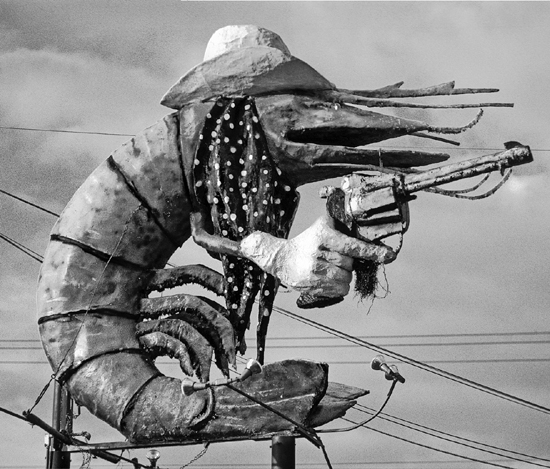
Two giant dueling shrimp with cowboy hats and six-shooters once graced the parking lot of Christie’s Seafood Restaurant on South Main in Houston
Palmetto Inn Shrimp Fajitas
SERVES 2
At the Palmetto Inn, the shrimp, onions, and green peppers are brought to the table on a sizzling comal with warm flour tortillas, lime wedges, guacamole, and cold beer. You can serve them with shredded lettuce and chopped tomatoes if you prefer—just don’t forget the guacamole.
1 pound large shrimp, shelled
1 tablespoon vegetable oil
1 clove garlic, minced
1 teaspoon ground Mexican oregano
Sea salt and freshly ground black pepper
Cooking spray
1 onion, sliced
1 green bell pepper, coarsely chopped
1 lime
6 warm flour tortillas
Lime wedges
All-American Guacamole, chilled
In a mixing bowl, toss the shrimp with the oil, garlic, oregano, salt, and pepper and allow to marinate for 30 minutes in the refrigerator.
Using the medium setting on a gas grill or a low charcoal fire, heat up a griddle or comal that fits on the grill. You will need a lid that will fit over the shrimp as it cooks. Oil the griddle with some cooking spray and start cooking the onion and bell pepper. Place the cover over the vegetables and allow the steam to soften them, removing the cover and stirring every few minutes. When the onion and pepper are nicely browned, add the shrimp and stir. Allow the shrimp to cook for 2 or 3 minutes, until they begin to turn opaque. Squeeze the lime juice over the shrimp and cover to capture the steam. The shrimp are done when they begin to curl, about 5 to 7 minutes total cooking time depending on the heat of the fire and the size of the shrimp. Do not overcook. Remove the shrimp and vegetables and serve immediately with tortillas, lime wedges, guacamole, and your favorite beverage.
Grilled Shrimp and Guacamole Salad
SERVES 4
You’ll enjoy the contrast of the hot shrimp and cold guacamole in this “hot and cold” salad.
Four 8-inch wooden skewers, soaked in water for 15 minutes
1 pound jumbo shrimp (16 shrimp)
½ cup Texas red grapefruit juice
¼ cup jalapeño jelly
2 cloves garlic, minced
1 tablespoon vegetable oil
2 tablespoons soy sauce
Cooking spray
1 head of butter lettuce, leaves washed, cleaned, and dried
All-American Guacamole, chilled
Sea salt
1 Texas red grapefruit, supremed and chilled
Cilantro sprigs, for garnish
Green onion shavings, for garnish
4 lime wedges, for garnish
Place the shrimp on the soaked wooden skewers. Combine the grapefruit juice, pepper jelly, garlic, oil, and soy sauce in a small bowl. In a baking dish, cover the shrimp with the marinade; cover with plastic wrap and place in the refrigerator for 30 minutes.
Light the grill. Shake the shrimp skewers to remove excess marinade. Coat the shrimp with cooking spray and grill for about 2 to 3 minutes on each side, or until the shrimp are cooked through. Remove from the grill.
Arrange the lettuce leaves in a bed on 4 chilled salad plates. Divide the guacamole among the plates, placing it in a lettuce “cup” in the center of each plate. Remove the shrimp from the skewers and place 4 shrimp on top of the guacamole and season with salt to taste. Arrange the grapefruit supremes around the shrimp on the bed of lettuce. Garnish with the cilantro, green onion shavings, and lime wedges. Serve immediately.
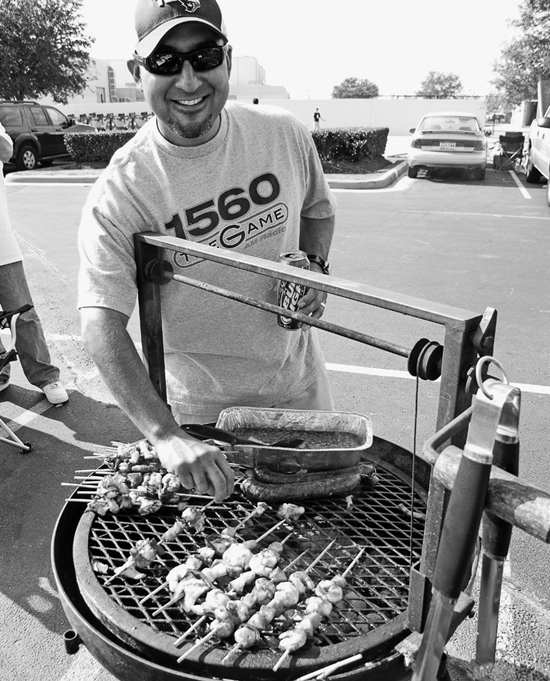
Shrimp kebabs are a favorite tailgating appetizer—the grilled shrimp are also great for shrimp cocktails
John Hamman’s Shrimp Kebabs
SERVES 4
John’s Tailgating Team was making these incredibly colorful appetizers when I stopped by their huge trailer parked in front of Reliant Stadium in Houston. These guys are actually a race car team that spends most of their time at auto racing events. When the racing season is over, they start slumming with the football fans. But wherever they go, they sure eat well.
16 jumbo shrimp
20 1-inch squares bell pepper
20 1-inch squares red onion
20 1-inch squares pineapple
Four 10-inch wooden skewers, soaked in water for 15 minutes
FOR THE MARINADE
1 cup pineapple juice
¼ cup olive oil
¼ cup Worcestershire sauce
2 tablespoons garlic powder
Sea salt to taste
Freshly ground black pepper to taste
Clean and shell the shrimp. Alternate the bell pepper, onion, pineapple, and shrimp on the skewers. Combine the marinade ingredients in a mixing bowl. Place the skewers in a baking dish, pour the marinade over the top, and turn the skewers to coat well. Grill over medium heat until the shrimp are cooked through and beginning to curl, between 5 and 7 minutes depending on the heat of the fire and the size of the shrimp. Do not overcook.
MAKES 12
It was Drago’s in Metairie, Louisiana, that made char–broiled oysters famous.
Jimmy G’s on Sam Houston Parkway in Houston does a great job with them too. Gilhooley’s does them over a pecan wood fire that gives the oysters a wonderful smoky flavor. Also known as barbecued oysters, these are made by putting a fresh shucked oyster on a grill and spooning in some melted butter and garlic; you can add parmesan if you like.
4 tablespoons (½ stick) butter
4 cloves garlic, minced
Salt and freshly ground black pepper
12 freshly shucked oysters
Freshly grated parmesan cheese (optional)
Melt the butter in a pan, add the garlic, and add salt and pepper to taste. Heat a grill. Put the shucked oysters over the hot part of the fire. When the shell gets hot, the oysters will quickly begin to sizzle. Divide the garlic butter among the oysters. Don’t be alarmed if the butter causes the fire to flare up; it adds a char-grilled flavor. Sprinkle parmesan over the top after the butter, if desired. Serve immediately with crusty bread for dipping.
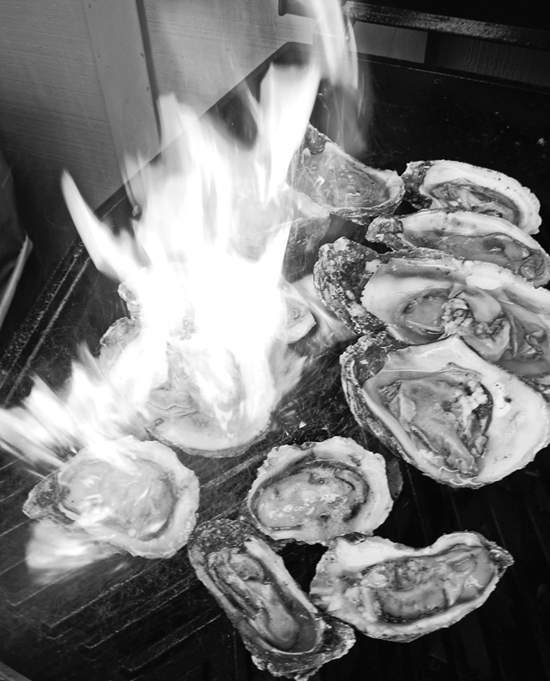
It takes a while for the shells to heat up—then the oysters flare up as the butter boils over
SERVES 8
David Garrido serves these at his upscale taco bar in Austin. The fish they call mahimahi in Hawaii is called dorado in the Gulf of Mexico. It has a bold flavor that tastes great with hot sauce and bacon, lettuce, and tomato on a taco.
1 pound dorado (mahimahi) fillets
Olive oil
2 tablespoons powdered chile
8 tortillas (see Taquero-Style Tacos)
4 slices bacon, fried crisp and crumbled
1 cup chopped iceberg lettuce
1 tomato, seeded and diced
½ cup salsa of your choice
1 cup Cilantro Cream
Prepare the grill. Coat the fish evenly on both sides with olive oil and chile powder. Place the fish on the grill over medium-high heat and cook for 2 to 3 minutes. Turn and cook for 3 minutes longer, or until just done. Do not overcook or the fish will be tough. Remove from the grill and cut the fish into strips, removing any skin or bones. Divide the fish among the tortillas. Top with the bacon, lettuce, tomato, salsa, and Cilantro Cream.
SERVES 4 TO 6
In the heyday of the Palmetto Inn chain, Moises Carrasco used to take the family to Acapulco every year. Deep-sea fishing was among Moises’s favorite pastimes. In those days, eating the fish was part of the experience. Today, most trophy-size fish are taken by catch-and-release fishermen. After a few photographs, which are used to re-create a replica of the fish for mounting, the swordfish or marlin is thrown back. Of course, you can find swordfish in the seafood store and some marlin are still eaten in Mexican resorts. Fish steaks from big fish like swordfish, marlin, shark, or tuna are great cooked on a hot grill and drizzled with a little citrus-pepper sauce. Err on the rare side; fish steaks get tough quickly if overdone.
2 pounds fresh swordfish, marlin, shark, or tuna steaks
Salt and freshly ground black pepper
Juice of 2 limes
1 clove garlic, minced
½ serrano or habanero pepper, seeds and stem removed, minced
¼ cup vegetable oil
Season the fish steaks with salt and pepper. Combine the lime juice, garlic, serrano or habanero pepper, and oil in a bowl and toss the steaks in this mixture. Let marinate for 15 minutes. Grill quickly over a medium-hot grill, about 5 minutes per side for a 1-inch-thick steak, 2½ minutes per side for a ½-inch steak. Drizzle the marinade over the steaks as they cook. Do not overcook.
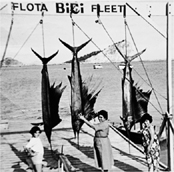
The carrasco family loved to go deep-sea fishing
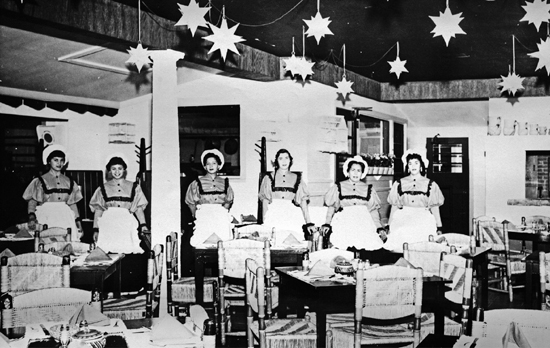
Waitresses in costume at the Palmetto Inn in the 1960s
Republic of the Rio Grande Grilled Tuna and Grapefruit Supreme Salad
SERVES 4
A restaurant in McAllen, Texas, called Republic of the Rio Grande Grill and Cantina invented this entrée-size grilled tuna salad with grapefruit sections and red onions on top. It’s a classic combination of South Texas flavors—and a very healthy dinner.
2 ½ Texas red grapefruits
1 tablespoon white wine vinegar
¾ cup olive oil
1 clove garlic, minced
¼ teaspoon salt
Freshly ground black pepper
1 teaspoon minced jalapeño pepper, or hot pepper sauce
4 tuna steaks, 6 to 8 ounces each
6 cups mixed salad greens
2 tablespoons chopped fresh cilantro leaves
8 red onion slices
Peel and supreme 2
grapefruits; set aside. Squeeze the juice from the other half grapefruit into a measuring cup; it should yield about ¼ cup of juice.
To make the salad dressing, combine the grapefruit juice, vinegar, oil, garlic, salt, freshly ground black pepper to taste, and minced jalapeño in a medium bowl; mix well. Cover and refrigerate the salad dressing.
Place the tuna steaks in a shallow dish. Pour 1 tablespoon of dressing over each piece of tuna. Turn the tuna in the marinade to coat. Cover with plastic wrap, or place all of the tuna steaks and marinade in a plastic bag, and refrigerate for 1 hour.
Light the grill. Remove the tuna from the refrigerator and allow to come to room temperature. Grill for about 4 minutes per inch of thickness for rare, 6 minutes for medium or until done to taste, turning at least once.
To serve, toss the greens with the salad dressing in a mixing bowl. Divide the dressed greens among 4 plates. Top each with a grilled tuna steak, then sprinkle with freshly ground black pepper. Spread grapefruit supremes over the top of the salad. Garnish with the cilantro and red onion slices.
Grapefruit Supremes
When I was a kid, the thing I liked best about grapefruit was that you got to spoon unlimited amounts of sugar on it. I remember broiled grapefruit with brown sugar on top, too; the sugar caramelized into a crunchy candy coating. Back then, everybody knew that grapefruit was too sour to eat unsweetened, especially for kids. Today, I would never think of pouring sugar on a Texas red grapefruit. And neither would my kids. They like their grapefruit without sugar, thank you, but they still insist that Dad section it out for them into skinless “supremes.”
Supremes of grapefruit are a spectacular topping for salads or seafood dishes. They are also called for in the awesome Texas Red Grapefruit Salsa.

CUT OFF all the peel, the white pith, and the outer part of the membrane that surrounds each section of grapefruit.
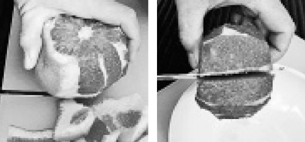
SLIDE A KNIFE in between the fruit and the membrane on one side and “flip” the naked fruit out of the membrane and into a bowl. Repeat with every section. Squeeze the juice from any remaining bits of fruit into the bowl.
Tampico Snapper a la Plancha
SERVES 4
John Stage is the founder of Dinosaur Bar-B-Que, a famous barbecue joint in New York. Stage called me when he was in Houston a couple of years ago. He and his posse had already eaten a lot of Texas barbecue and they wanted some Gulf seafood for a change. So I took them to Tampico, a Mexican ostioneria (oyster bar) and grill. We ordered Mexican beers and tequila shots and some shrimp cócteles.
For our entrée, I dragged Stage to the fish counter. The beauty of Tampico’s Mexican seafood market concept is that the whole fish are kept up front on a bed of ice. You pick out the exact fish you want and pay for it by the pound. There are several varieties depending on the season, but my top choice is Gulf red snapper, which is referred to here by its Mexican name, huachinango (pronounced “watch-ee-NONG-o”).
When you order whole snapper a la plancha, you get the fish griddle-cooked with onions and green peppers. It runs eleven dollars a pound, and a five-pound fish will feed a big crowd. I usually add a pound of shrimp and a couple pairs of frog’s legs to turn my huachinango a la plancha into a custom seafood platter.
1 whole red snapper, about 2 pounds
½ cup olive oil
2 onions, one minced and one cut into thick slices
3 tablespoons freshly squeezed lemon juice
1 tablespoon ground Mexican oregano
Cooking spray
1 green bell pepper, cored, seeded, and cut into thick slices
½ pound shrimp, shelled and cleaned
Light the grill. Clean and scale the snapper. Rinse the fish and cut off the gill fins. With a sharp knife, make three vertical slashes about 1½ inches apart along each side of the fish all the way to the bone.
Combine the olive oil, minced onion, lemon juice, and oregano in a small bowl. Put the fish in a large baking dish. Bend the fish so that the slashes open along one side. Spoon the marinade into the fish. Repeat on the other side. Marinate in the refrigerator for 30 minutes.
Spray a griddle or comal with cooking spray and cook the sliced onion and bell pepper over low heat on one side of the grill. Set the other side of the grill to medium heat. Spread the fish apart so it stands on its rib cage and cook the fish standing up on the grill over medium heat for 10 minutes. Put the onion and pepper mixture aside and move the fish to the griddle or comal. Cook the fish on one side for 5 minutes, then turn and cook for 5 minutes on the other side or until cooked through. Total cooking time should be roughly 10 minutes per inch of thickness. Add the shrimp to the griddle or comal during the last 3 minutes of cooking.
To impress the crowd, load a platter or a sizzling comal with the caramelized onions and peppers and place the whole fish on top. (You can also use a platter.) When the fish is cooked through, the flesh will fall away from the bone easily along the slash lines when you carve it. Serve with tortillas and condiments of your choice.
WHOLE FISH
Cooking a whole fish on a grill is a challenge. Fish has a tendency to stick to the grill and fall apart. There are accessories such as fish baskets and fine-mesh grill overlays to make it easier. This is where a comal or griddle comes in handy. You can start the fish on the grill to get some grill marks and color, and then transfer it to the comal to finish it. If you don’t have a comal, you can also use aluminum foil. For a really easy method, check out the recipe for Redfish on the Half Shell.
Redfish on the Half Shell
SERVES 4
Here is an old Texas fish-camp recipe: you Fillet the fish, but leave the scales on. Then grill the fish on the scale side only, basting often. The scales curl up to hold the marinade. When it’s done, the fish slides right off the blackened scales, which usually stick to the grill.
2 cloves garlic, minced
2 tablespoons minced fresh flat-leaf parsley leaves
¼ cup olive oil
Juice of 1 lemon, plus 1 lemon cut into wedges
Salt and pepper
One 3- to 4-pound redfish, filleted, scales left on
Light the grill. Place the garlic, parsley, olive oil, and lemon juice into a mixing bowl and whisk well. Lightly salt and pepper the fish fillets. Over a medium fire, place the fish, skin down, on the grill grate. Cook slowly for about 30 minutes, basting with the olive oil and lemon juice mixture every 5 minutes. When the fish is cooked through, pull gently to see if the skin is stuck to the grill. If it is, slide a large spatula carefully between the skin and the meat, removing the meat from the grill while leaving the skin. If the skin isn’t stuck to the grill, you can separate the skin from the fillet on the serving platter.
Remove any skin or bones and divide the two fillets into four servings. Moisten with any leftover olive oil and lemon mixture. Serve immediately with lemon wedges.
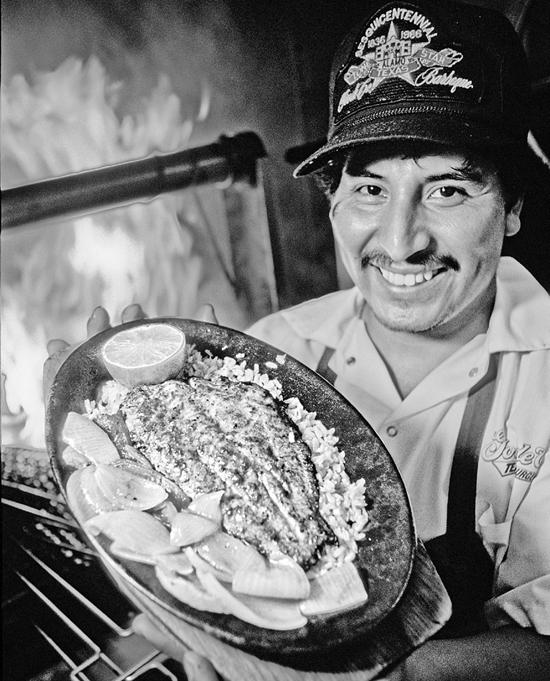
MESQUITE-GRILLED fish filet on a sizzling platter at Goode Company Seafood in Houston



